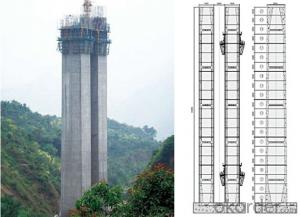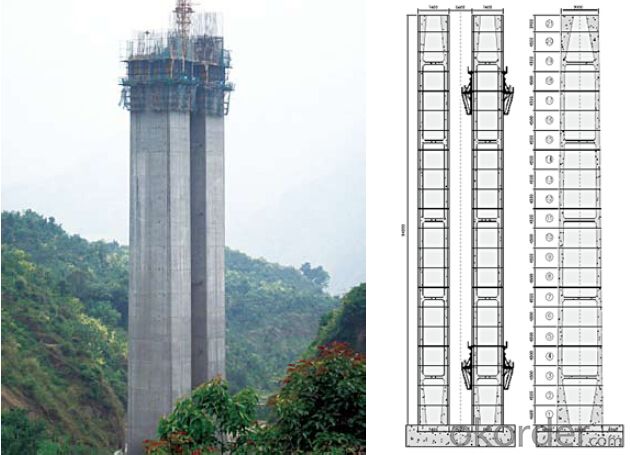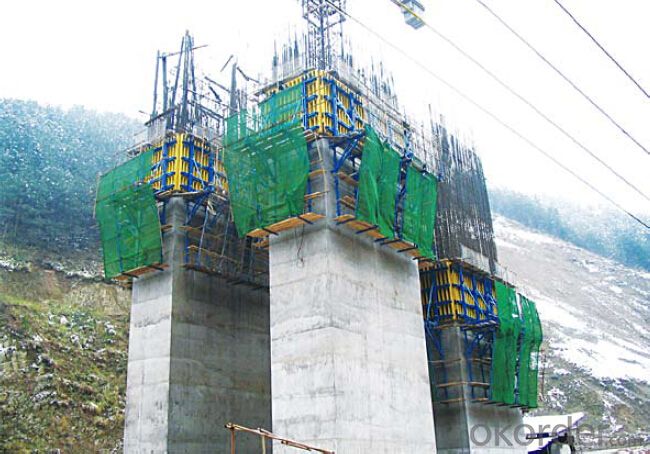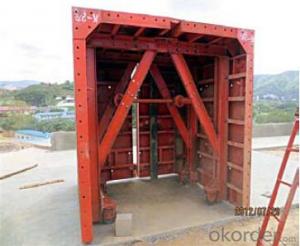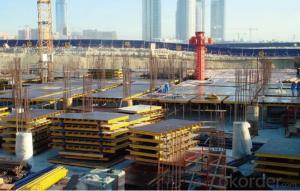Climbing-bracket CB-240 for formwork and scaffolding systems
- Loading Port:
- Tianjin
- Payment Terms:
- TT OR LC
- Min Order Qty:
- 50 m²
- Supply Capability:
- 1000 m²/month
OKorder Service Pledge
OKorder Financial Service
You Might Also Like
Climbing Bracket CB240 & CB210
They are framework brackets for supporting large-area wall formwork.
Typical applications for the CB240&CB210 are pier and column/shear wall/core walll/ in the
building.
CB210 has smaller size than CB240, it will be cost effective in some condition.
Characteristics:
◆ High bearing capacity
The high loading capacity of the brackets allow very large scaffold units. This saves the number
anchor points required as well as reducing climbing times.
◆ Simple moving procedure by crane
Through the strong connection of formwork together with the climbing scaffold, both can be moved
as a single climbing unit by crane. Thus valuable time-savings can be achieved.
◆ Fast striking process without a crane
With the retrusive set, large formwork elements can also be retracted quickly and a minimum of
effort.
◆ Safe with work platform
The platforms have assembled firmly with bracket and will be climbing together, without scaffolding
but can work safely in spite of your high location.
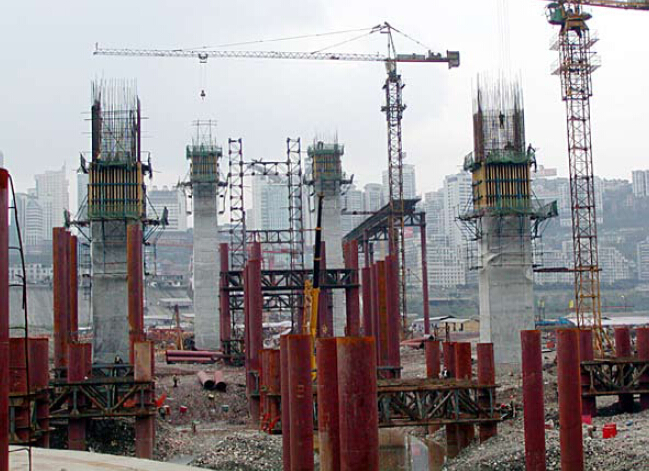
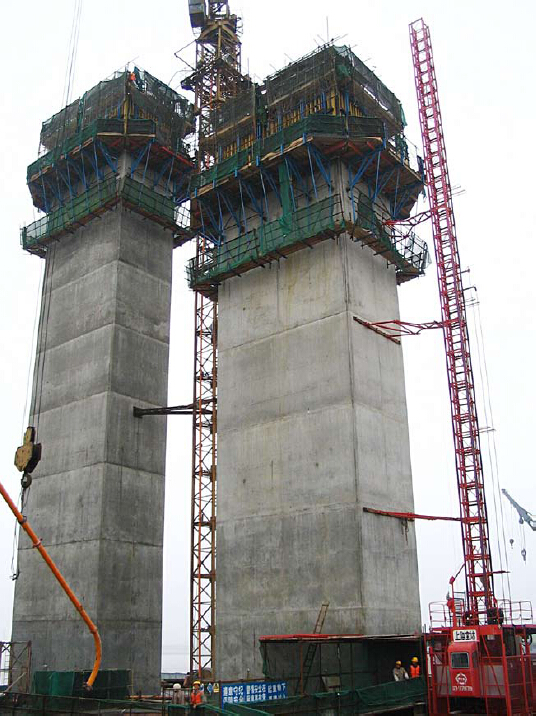
- Q: How does steel formwork affect the overall project cost estimation?
- The overall project cost estimation can be significantly influenced by the use of steel formwork. Although steel formwork may have a higher initial cost when compared to materials like timber or plywood, it offers several advantages that can lead to long-term cost savings. To begin with, steel formwork is extremely durable and can be used multiple times. Unlike timber or plywood formwork that may require replacement after a few uses, steel formwork can withstand numerous cycles, reducing the need for frequent replacements. This not only saves on material costs but also reduces the labor and time required for formwork installation and removal. Moreover, steel formwork provides superior quality finishes, resulting in a decreased need for surface treatments or plastering. This saves both material and labor costs associated with finishing work. Furthermore, steel formwork offers greater precision and dimensional accuracy, reducing the need for rework or adjustments during construction. This helps minimize material wastage and saves time and labor costs. In addition, steel formwork is highly resistant to moisture and weathering, allowing it to be used in various weather conditions without compromising its structural integrity. This flexibility enables more efficient construction scheduling, reducing downtime and potential cost overruns. Lastly, steel formwork can support greater concrete pouring heights and pressures, enabling faster construction and increased productivity. This can result in accelerated project timelines and reduced labor costs. In conclusion, while steel formwork may have a higher initial cost, its durability, reusability, improved finishes, precision, resistance to weathering, and ability to support larger concrete pours can lead to significant cost savings in terms of material, labor, and time. Therefore, steel formwork has a positive impact on the overall project cost estimation.
- Q: What are the safety considerations when using steel formwork?
- When using steel formwork, there are several safety considerations that need to be taken into account. Firstly, it is important to ensure that the formwork is properly installed and secured to prevent any collapses or accidents. Regular inspections should be conducted to check for any signs of wear or damage that could compromise its stability. Another safety consideration is the proper handling and storage of steel formwork. It can be heavy and cumbersome, so workers should be trained in proper lifting techniques to avoid strains or injuries. Adequate storage facilities should be provided to prevent any damage or tripping hazards. Additionally, when working with steel formwork, workers should wear appropriate personal protective equipment (PPE) such as helmets, gloves, and safety boots to protect themselves from any potential hazards or falling debris. They should also be trained in safe work practices, including proper use of tools and equipment, as well as the correct procedures for dismantling the formwork after use. Overall, by following these safety considerations, the risks associated with using steel formwork can be minimized, ensuring a safe working environment for all involved.
- Q: Can steel formwork be used for precast concrete arches?
- Precast concrete arches can indeed utilize steel formwork. This material, known for its versatility and durability, proves highly capable of constructing intricate shapes and structures, including arches. During the casting process, steel formwork offers exceptional support and stability, ensuring the precise and accurate formation of arches. Moreover, steel formwork easily adapts to various arch designs and dimensions, thanks to its customizable nature. Its strength and rigidity further enable it to withstand the pressure and weight of the concrete during the curing process. Consequently, steel formwork emerges as the preferred choice for constructing precast concrete arches due to its flexibility, strength, and reliability.
- Q: What are the different types of joints used in steel formwork construction?
- There are several different types of joints used in steel formwork construction, including butt joints, lap joints, groove joints, and tongue and groove joints. These joints are designed to provide stability and strength to the formwork system, allowing it to withstand the pressure exerted by the concrete during the pouring and curing process.
- Q: What are the different types of steel formwork systems available in the market?
- In the market, one can find a variety of steel formwork systems that cater to specific construction needs and requirements. 1. The most commonly used steel formwork system in construction projects is the traditional steel formwork. It involves assembling steel plates and angles to create a temporary mold for concrete placement. This type of formwork is versatile and suitable for various structures. 2. Another type is the modular steel formwork system, which comprises pre-made modular panels that interconnect to form a mold for concrete placement. It is lightweight, easy to assemble and disassemble, and can be reused multiple times, making it cost-effective and time-efficient. 3. For tunnel and underground structure construction, tunnel formwork systems are designed. They utilize steel plates assembled to create a continuous mold along the tunnel's length. These systems are durable, capable of withstanding high pressures, and provide a smooth finish for the tunnel walls. 4. Climbing formwork systems are commonly used in high-rise construction projects. They feature a self-climbing mechanism that allows the formwork to be vertically raised or lowered as the construction progresses. By eliminating the need for cranes or external support, these systems are efficient and safe. 5. Slip formwork systems are employed for tall and slender structures like towers and chimneys. They involve a continuously moving formwork that is raised vertically as the concrete hardens. These systems ensure a smooth and uniform finish while being highly efficient for large-scale construction projects. These examples demonstrate the variety of steel formwork systems available in the market. The selection of a system depends on factors such as the type of structure, project timeline, budget, and specific construction requirements. It is crucial to consult with experts and consider these factors before choosing the most suitable steel formwork system for a project.
- Q: What are the different types of joints used in steel formwork?
- Steel formwork for construction projects commonly utilizes various types of joints to ensure stability and proper alignment of the system. 1. The most basic joint is the butt joint, which involves placing two formwork panels together with their edges abutting. Additional reinforcement, such as steel plates or angles, is often used to enhance strength and stability. 2. Corner joints, as the name suggests, connect formwork panels at corners. These joints are usually reinforced with steel angles or brackets to ensure proper alignment and support. 3. T-joints are used when formwork panels intersect at a perpendicular angle. This joint involves connecting three panels together, with one positioned perpendicular to the other two. 4. L-joints are similar to T-joints but are used when panels intersect at a 90-degree angle. This joint involves connecting two panels together, with one positioned perpendicular to the other. 5. Lap joints are used to connect long formwork panels, creating a continuous surface. This joint involves overlapping the edges of two panels and securing them with bolts or clamps. 6. Hinged joints are employed when adjustable or movable formwork panels are required. This joint allows for flexibility in placement and can be locked in different positions to accommodate various shapes and sizes. It is essential to consider the specific requirements of the construction project, including the desired formwork system and structural design, when selecting the appropriate joint. This selection plays a crucial role in ensuring the overall stability and strength of the formwork system.
- Q: Production of steel plate for bridge steel plate SPHC and Q235 which material is good? What is the difference?
- Represents the hot rolled steel plate (which corresponds to the cold rolled plate is SPCC)
- Q: Can steel formwork be used for curved or irregular-shaped structures?
- Yes, steel formwork can be used for curved or irregular-shaped structures. Unlike traditional timber formwork, steel formwork offers greater flexibility and strength, making it suitable for complex shapes and designs. Steel formwork can be easily bent or fabricated into the desired shape, enabling the construction of curved walls, columns, and slabs. Additionally, steel formwork provides excellent support and stability, ensuring the accuracy and precision of the final structure. Its durability and reusability further make it a cost-effective choice for projects involving curved or irregular-shaped structures.
- Q: What are the different types of bracing used with steel formwork?
- The stability and strength of the structure being formed are ensured through the utilization of various types of bracing with steel formwork. Each type serves a specific purpose in achieving this goal. 1. Diagonal Bracing: To prevent lateral movement of the formwork and provide stability, diagonal braces are employed. These braces are typically positioned at an angle between two corners of the formwork, creating an "X" shape. They assist in evenly distributing loads and resisting the forces acting on the structure. 2. Vertical Bracing: In order to support the formwork vertically and prevent sagging or bulging, vertical braces are utilized. These braces are usually installed at regular intervals along the height of the formwork, offering additional support and rigidity to the structure. 3. Horizontal Bracing: Horizontal braces are implemented to counteract the horizontal forces acting on the formwork. They are placed horizontally, typically at the top and bottom of the formwork or at specific intervals along its length. This provides stability and prevents deformation caused by external loads. 4. Tension Rod Bracing: Tension rods are employed to distribute loads and reinforce the formwork. Depending on the specific requirements of the structure, these rods are typically installed diagonally or horizontally. Tension rod bracing is especially effective in resisting excessive deflection and preventing the formwork from collapsing under heavy loads. 5. External Bracing: When additional support is necessary, especially in the face of high wind loads or other external forces, external bracing is used. These braces are usually positioned on the outer side of the formwork and are designed to offer extra stability and prevent deformations caused by external factors. 6. Tie Rods: To hold the formwork together and apply uniform pressure on the structure, tie rods are employed. These rods are commonly installed horizontally or vertically and are tightened with nuts to secure the formwork in place. Tie rods also aid in evenly distributing loads across the formwork, preventing bulging or deformation. In summary, the different types of bracing utilized with steel formwork play a vital role in ensuring the stability, strength, and integrity of the structure being formed. They work collectively to resist external forces, distribute loads evenly, and prevent deformations or failures during the construction process.
- Q: What are the different types of formwork joints used in steel formwork?
- In steel formwork, there are various types of formwork joints that are commonly used. These joints are designed to ensure the proper alignment, stability, and strength of the formwork system. Some of the different types of formwork joints used in steel formwork include: 1. Butt Joint: This is the most common type of joint used in steel formwork. In this joint, two formwork panels are aligned end-to-end, with the edges in direct contact with each other. The panels are then secured using bolts or clamps to ensure a tight fit. 2. Lap Joint: In a lap joint, one formwork panel overlaps the other, creating a connection between the two panels. This joint provides additional strength and stability to the formwork system. The overlapping portion is usually secured using bolts or clamps. 3. Corner Joint: As the name suggests, a corner joint is used to connect two formwork panels at a corner. This joint is typically formed by cutting and welding the panels at a 90-degree angle. The welded joint ensures a strong and secure connection between the panels. 4. T-Joint: A T-joint is formed when one formwork panel intersects another panel at a right angle, creating the shape of the letter "T". This joint is commonly used in complex formwork systems where multiple panels need to be interconnected. 5. Hinged Joint: A hinged joint is used when there is a requirement for a flexible connection between two formwork panels. This joint allows for movement and adjustment of the panels, which can be useful in situations where the formwork needs to accommodate irregular shapes or angles. 6. Slip Joint: A slip joint is used to create a temporary and adjustable connection between two formwork panels. This joint allows for easy removal and repositioning of the panels during the construction process. It is often used when the formwork needs to be adjusted for different pour heights or angles. These are just a few examples of the different types of formwork joints used in steel formwork. The choice of joint depends on the specific requirements of the construction project, including factors such as load-bearing capacity, ease of assembly and disassembly, and overall stability of the formwork system.
Send your message to us
Climbing-bracket CB-240 for formwork and scaffolding systems
- Loading Port:
- Tianjin
- Payment Terms:
- TT OR LC
- Min Order Qty:
- 50 m²
- Supply Capability:
- 1000 m²/month
OKorder Service Pledge
OKorder Financial Service
Similar products
Hot products
Hot Searches
